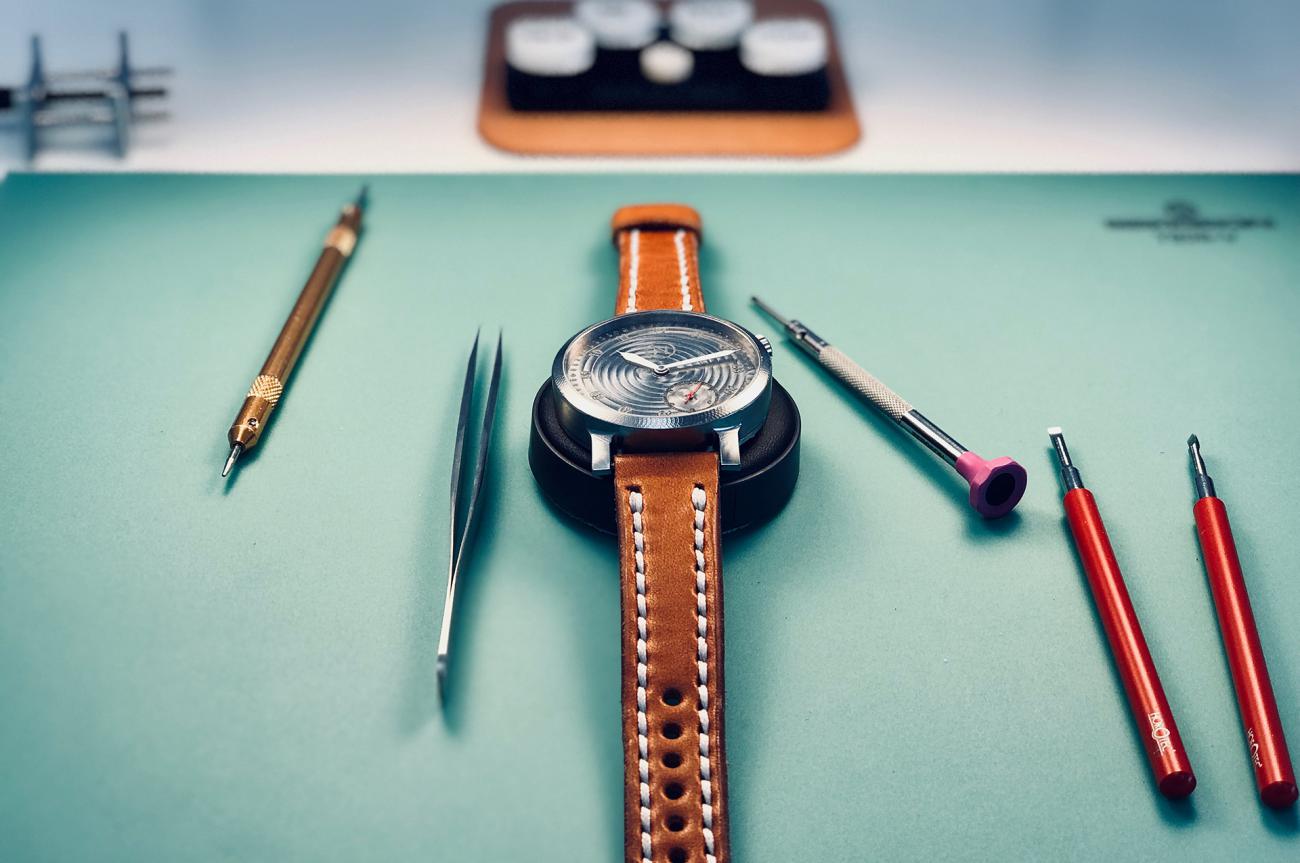NO ONE NEEDS A WATCH.
After all, cellphones can give the precise time (and weather and stock updates and news and so much more) with the click of a button, and those who don’t have one can, almost always, simply find someone who does. Managing time has never been so easy.
But saying no one needs a watch is like saying no one needs art, or music, or poetry.
It may be true on a pragmatic level, but where would we be in a world without watercolours? Without “Wheat Kings,” or The West Wind, or “The Cremation of Sam McGee?” Or without handcrafted timepieces that provide a comforting weight on the wrist and a reminder to slow down and savour time, and not simply manage it.
Steve Christensen, a 2008 grad of Lethbridge College’s Business Administration program, says the mission of NOVO Watch is to create the world’s most beautiful and storied timepieces. He does that by using reclaimed materials that reflect the history and culture from which they came.
Steve Christensen (Business Administration - Management 2008) has always loved watches. Starting in elementary school, when he coveted a Timex with the Velcro strap (could anything be cooler?), timepieces cast a spell over him. Without fail, a watch rested at the top of his Christmas list, and any money he saved went to buy newer and more marvellous models. Early on, he wanted to know exactly how they worked, and so he especially loved watches where he could see the movement – the mechanisms inside the case that make them tick.
Today, Christensen has combined that life-long zeal with entrepreneurial innovation to build a thriving business called NOVO Watch, which creates handcrafted timepieces in small batches using reclaimed materials that tell a story. As Christensen explains, NOVO watches are designed to reflect the history and culture from which they came.
So the steel cases, casebacks and dials of his newest watches? They come from the rail that was laid across the southern Alberta landscape more than 130 years ago. The wooden boxes that hold each watch? They’re hewn from reclaimed southern Albertan barn wood. The blacksmithing, the machining, the leather work, even the stitching – they are all done to the sounds of a chinook, not a crowded factory floor.
“I really think we are getting close to making one of the coolest watches in Canada,” Christensen says. “We want to keep on repurposing pieces of history. That’s the idea. There are so many great stories to be told.”
“A timepiece,” says Jordan Dicklin, executive director of the American Watchmakers-Clockmakers Institute, “even if it is made by a machine, is interesting and intriguing in the way it works. But when you buy a piece that is handcrafted, you are acquiring a piece of art, something that you can appreciate. It’s the difference between buying a poster in the mall and a painting created by an artist. Both have an important role to play, but one of them will hold a place of importance for a long time. One of them will last.”
Christensen didn’t set out to become the creator of lasting timepieces. After graduating from Lethbridge Collegiate Institute, he came to the college to study business in the 2+2 program, where he spent two years in the Business Administration program on campus before taking his diploma and moving on to the University of Lethbridge, where he earned a Bachelor of Management degree. He says he loved his years at the college.
“My college experience was amazing,” he recalls. “We had all of these people coming in who had relevant, real-life experience. Some of my teachers owned their own businesses. It was so much more immersive than the university, and the one-on-one time with the instructors was unbeatable. You’d make these great relationships, and they were so approachable.
“In a way, I think the college lets you bloom a little more. You were really comfortable in a classroom setting.”
With more confidence and a solid foundation in business, Christensen headed to the university. It was in the back of a Management classroom that he started drawing watches, playing with size and design as he dreamed about what the perfect watch would look like. Near the end of his program, he won some money and had planned to buy a truly amazing watch – and realized none of them were quite right. So instead, he used that money to set out and make his own.
My college experience was amazing,” he recalls. “We had all of these people coming in who had relevant, real-life experience. Some of my teachers owned their own businesses. It was so much more immersive than the university, and the one-on-one time with the instructors was unbeatable.
Even then, his goal wasn’t to make handcrafted masterpieces. He found a mentor in the United States to help him source material from China and sent off for samples. The first samples he received were “really mediocre” but over the years he refined them, always on a quest to create something even better than before.
At the same time, he went off to Johns Hopkins University in Maryland where he earned a master’s degree in Real Estate Development in 2011.
“I was at the end of my master’s and had my last set of samples,” he remembers. “They were perfect. Amazing. And after I graduated, my wife and I started talking. We realized there were two paths – I could go the corporate route, which is awesome, and we’d be comfortable, but the likelihood of me stepping back and doing my own thing ever again would be slim. Or, we could continue living like students, do the start-up thing and give it a try.
“That was five years ago.”
The first NOVO watches were “super ghetto, but it worked. Those first ones are funny to look back on now. Nothing is perfect from the first go – ever – and if it is, you probably took too long to do it.”
But those first watches gave him a product to market, and he looked to the web to do the heavy lifting. The first orders started coming in, and as they did, Christensen reached out to watch blogs, and some of them picked up and shared his story.
He started earning awards, including being a top 10 finalist in the FP Journe Young Talent competition in 2017, an annual contest the high-end Swiss watch manufacturer runs each year to find the most talented young watchmaking apprentices in the world and support them in their routes to independence.
“When we started doing this [designing watches and having partners in China make the parts], there was no one else doing it,” Christensen recalls. “It was expensive and contact with China was really hard. But then with start-ups like Kickstarter, all of a sudden our unique story wasn’t unique any more. There was a flood of new watch brands, and a lot of those companies started with big marketing dollars. Our sales started levelling off.”
Each watch in the Coalbanks Collection travels through the hands of five artisans from start to finish: watchmaker Christensen; blacksmith Drue Crāpo; machinist Joel Kistenfeger at Lethbridge Machine; leathersmith Brandon Strang at Timber and Hide; and barnwood master Dusty Mitchell at Dusty Lumber Co.
That’s what got Christensen thinking about making a masterpiece. To get started, he looked to history. “We knew we wanted to do something with Lethbridge, with handmade watches, with doing our own quality control here,” he says. So he worked with a mentor in Switzerland, found a local blacksmith, machinist, leather craftsman and boxmaker, and got to work.
The team started by creating the Coalbanks Collection. They used steel rail from the Galt Mine site in Lethbridge, a coal mining operation that opened in 1882 and was a catalyst for the economic development of southern Alberta. The name of each watch model reflects the steel’s origins. The Blaenavon 1882 uses steel from track that was produced at the Blaenavon Ironworks of Wales in 1882; the Dowlais 1884 uses steel from the Dowlais Ironworks in Wales manufactured two years later; while the Barrow 1885 features steel produced a year later at Barrow Hematite Steel Company in England, which at the turn of the 20th century was the largest steel mill in the world.
“These days a lot of stuff is never touched with human hands, but this,” Christensen says, picking up a piece of Dowlais rail he keeps in his downtown Lethbridge studio, “this rail is more than 130 years old and barely has any surface rust. It was manufactured by people, and laid by people, and a lot of effort was put into it at every stage of the process. There were so many people involved in creating this rail and bringing it to Canada. That world was such a different place then. Those tracks were instrumental in the building of our country and the building of our city.”
Steel – so strong and durable that it is used to build skyscrapers and ships – is also a perfect medium to manufacture something meant to last for generations.
Calling on local connections, Christensen worked with a blacksmith and a machinist in southern Alberta to fashion the casing and dials. For the strap, he used Hermann Oak leather, one of the premier leather manufacturers in the United States, and turned to a local artisan to shape each band. He ordered the movements – the tiny gears and guts of the watch – from Switzerland. Recalling his own curiosity as a child about how watches work, he left the movement exposed under crystal, so the wearer can be hypnotized by the sweeping motion by simply turning the watch over. Finally, he assembled each watch himself at his spartan, sunny downtown office on a desk raised to the optimal height by paint cans.
The entire process takes four to six weeks, and the cost – $3,450 each – reflects that. “I went from making $200 watches (with mass-produced parts from China) to $3,500 watches (made by hand), which is shocking to a lot of people,” Christensen acknowledges. “We knew our current customers weren’t the ones who were going to buy them. But it’s one of those things where if we wanted to change how we were working and how we would grow – well, we just had to grow.”
The customers – many of whom gave the watches as Christmas gifts this last holiday season – love the finished product. Trish Gurr of Calgary bought a Coalbanks Collection watch for her husband, Glen, explaining that the ties to local history helped make the gift “a huge success.”
“My husband’s grandfather worked in the Galt Number 8 mine when he emigrated from Italy,” Gurr says. “He came to the Lethbridge area in 1912 at the age of 26 and worked in the mines to earn money to buy land, which he did. He ended up with a large dairy farm just north of Lethbridge. When I explained the repurposing of the mine tracks to our family [after Glen opened the gift], there were a few tears shed over its significance to our family history. Not only that, but they were very impressed by what a nice looking watch it was besides. “I look forward to this watch being a part of our family’s heritage going forward, and passing it on to our children and grandchildren.”
Nothing could make Christensen happier. He knows those kids will likely have cellphones as well, or whatever replaces them. They will have an infinite number of ways to find out the hours and minutes of each day. But they’ll have something more: a piece of art that will last for generations, will need no updates and will hold a special story – one that celebrates the past and reminds the wearers to make the most of their time.
About the Coalbanks Collection
Functions: Manually wound, 46-hour power reserve, hours, minutes, a sweeping second hand located at the five on the watch, Incabloc shock protection
Case, caseback, dial: Historical 130+ year’s old 1080 high manganese steel
Finishing: Ceramic coating to resist corrosion, abrasion, chemicals and impact
Front and back crystals: Sapphire
Band: Hermann Oak leather
Packaging: Reclaimed barn wood
Build time: Approximately four to six weeks
Love time: Approximately forever



